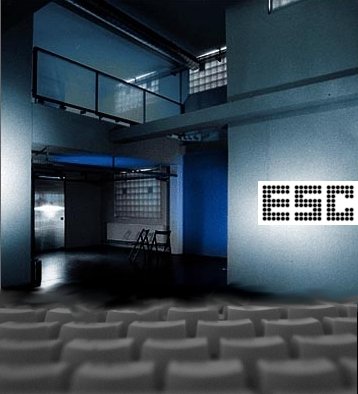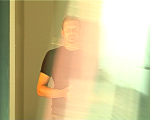
KUNST!
intro 2008
projekte
+ timetable
+ aktuell
künstler_innen
| kooperationen
| publikationen
leitbild
| kontakt
| map
| team
| archiv
| home
hosted by mur.at
|

CENTRAL
PROCESSSING UNIT
CPU ist ein Kooperationsprojekt zwischen
steirischer herbst, mur.at
und ESC im LABOR
Agnese Trocchi |
Lorenzo Cassulo |
Nanna Lueth |
Hannah Fitsch |
Wolfgang Temmel |
Karin Hofstätter |
Christian Stalzer |
Frank Barknecht |
Andrew Garton |
Ju Gosling |
Donna Metzlar |
Tatiana de la O |
Anne Roth & Andrej Holm |
Seda Gürses |
Eran Sachs |
Neset Özevin |
Anna Loosen |
Ernesto Rico-Schmid | Zoe Gudovic
back
Photos
Impressions from the Opening,
4.10.2008
first weekend/first workshops,
5.10.2008
OpenHouse I "Access" - Ju
Gosling, Men in White Coats, 17.10.2008
CPU Graz - das Programm/program
Eröffnung/opening weekend: 4. - 5.10.
The shadow of frequencies
Agnese Trocchi - Candida TV, und Lorenzo Cassulo
"The shadow of the frequencies" ist eine Multimediainstallation von
Candida TV, Teil der Manifesta 7, in der Ausstellung THE REST OF NOW
in Bozen. In Graz werden Agnese Trocchi - Candida TV, und Lorenzo
Cassulo kurze Videos erstellen und in das
TV-Syytem in Bozen einspeisen, das auf den nicht mehr verwendeten
VHF-Frequenzen der urbanen Zone in Bozen rund um das ex-Alumix-Werk
ausgestraht wird. Sie werden Videomaterial erzeugen und das System
SOMA vorstellen, das zur Abwicklung von Fernseh- oder Radiostationen eingesetzt wird.
Samstag, 4.10. und Sonntag, 5.10. Upload 14.00 - 19.00 Uhr
SOMA-Einführung: Sonntag, 5.10., 14.00 Uhr
"The shadow of the frequencies" is an installation realized by
CandidaTV as part of Manifesta 7, in the exhibition THE REST OF NOW.
The installation consists in a public TV broadcast controlled by the
freesoftware somasuite. The aim of the TV broadcast is to create a
contact with the abandoned areas of the brain: unexploited resources
that we can reactivate.
We are collecting short videos to feed the TV station that is narrow
broadcasting on the VHF frequencies from the abandoned urban area of the
ex- Alumix in Bolzano.
We will harvest video materials and learn about the use of soma to
manage a tv or radio palimspest from remote.
www.newmacchina.net/contatto
www.candidatv.tv
www.15multimedia.it
Data Cadavre
Nanna Lueth und Hannah Fitsch
Untersuchung wissenschaftlicher Bilder im Rahmen einer Tagung über die Verdatung des
Organischen.
Bilder werden in den Gesellschafts- und Naturwissenschaften gerne als
selbsterklärende Modelle des jeweiligen Wissenstandes eingesetzt, über
die Informationen leicht verständlich weitergegeben werden können.
Diese schnelle Vermittelbarkeit kann aber nur darüber funktionieren,
dass in den Bildern oder auch Diagrammen auf Wissenskonfigurationen
zurückgegriffen wird, die aus anderen Kontexten bekannt sind. Die
technisch-wissenschaftlichen Bilder können auch als
Aufschreibesysteme verstanden werden, die technische
Vermittlungsverhältnisse darstellen. Das Bild steht hier also als
Speicher gesellschaftlichen Wissens, als Dispositiv deren inhärenten
Diskurse, Herstellungsmechanismen institutionellen Wissens es
herauszuarbeiten gilt.
Zur Konferenz
Menschen - Zahlen - Transformationen. Verdatung des Organischen
im September 2008 in Berlin fügten die Künstler_innen
eine (audio-)visuelle Wissensproduktion hinzu. Querliegend zu den Panels präsentierten 3
Künstler_innen/Wissenschaftler_innen eine kollektive Produktion, die
sich besonders mit der Verwendung von Bildern in der Forschung und in
der Tagung beschäftigt. Sowohl den Vortragenden wie den Besucher_innen
der Tagung soll so eine weitere Ebene der Reflexion/Störung der
eigenen Vorannahmen, z.B. in Bezug auf textbasierte Wissenschaften und
Erkenntnisproduktion ermöglicht werden, die unserer Ansicht nach
Grundlage kritischer Forschung ist.



Video-Stills: Ulla Klopf
Eine Kunstgeschichte
von Wolfgang Temmel
"Künstler": Christian Stalzer
Kamera/Schnitt: Ulla Klopf
Beratung bei der Übersetzung in ÖGS
(Österreichische Gebärdensprache): Karin Hofstätter
www.temmel.org/arthistory/
"laut, lauter, gebärdensprache"
Wolfgang Temmel lädt ein
mit Karin Hofstätter; Linguistin; seit 1996 Mitarbeiterin der
Arbeitsgruppe Gebärdensprache am Institut für Translationswissenschaft der
Karl-Franzens-Universität Graz; Lektorin für ÖGS und Dolmetschen;
Gebärdensprachdolmetscherin - Ordentliches Mitglied im
Österreichischen
Gebärdensprach- dolmetscherInnen-Verband (ÖGSDV)
und
Christian Stalzer
Mitarbeiter am Institut für Translationswissenschaft der
Karl-Franzens-Universität Graz (seit 1995)
Lektor für Österreichische Gebärdensprache (ÖGS)
Behindertenvertrauensperson für allgemeines Universitätspersonal
"Die Kunst des 20.Jhdts. hat eine sehr, sehr gute Arbeit geleistet.
Welche Arbeit?
Die Augen und Ohren der Leute zu öffnen. Was Besseres hätte man denn
machen können?
Aber jetzt müssen wir unsere Aufmerksamkeit anderen Dingen zuwenden,
und diese Dinge sind sozial." John Cage
schusslig 1.7 beta
Frank Barknecht with "schusslig 1.7 beta", a Pd-based game that you
cannot win; Installation.
Nothing Known
audiovisuelle Installation, work-in-progress von Andrew Garton
Nothing Known ist eine Art anthropologische Studie über den Verlust
von Kultur, Tradition und Eigenheit innerhalb einer kulturellen
Diaspora entlang der Fragen nach Identität, Wissen und Motivation.
Garton nähert sich Bruno's Behauptung durch Betrachtung von
Netzwerken, Dokumentation(en) und Beobachtung in der möglichweise
letzten Dekade der Dekadenz.
An audio-visual installation by Andrew Garton
The ill-fated Italian philosopher, Giordano Bruno, stated that "nothing
can ever be known". Despite all we have our disposal, regardless of
millennia of thought, reflection and wisdom, in spite of the knowledge,
expertise and technologies we continue to consume, inundate and pollute
the finite resources supporting life on Earth.
Nothing Known is a quasi anthropological study of loss of culture,
tradition and native title within cultural Diaspora alongside the
artist's quest for identity, knowledge and purpose. Through networks,
documentation, observation and contemplation Garton considers Bruno's
assertion in what may well be the last decade of decadence.
http://wiki.apc.org.au/index.php?title=Nothing_Known
Queer Sarajevo Festival
Zoe Gudovic - Queer Sarajevo Festival
ESCLab I
14. - 16.10.2008 during exhibition time
Meeting
online meeting on topics of art and technology, focusing on relations
between these two, on the mutual influences, with Erinn Clarke
(debian developer, member of debian women, with participation of
Donna Metzlar (genderchangers), Tatiana de la O, and others.
OpenHouse I "Access"
17.10.2008, 19.30 Uhr
Will the Internet disappear?
What is this talk about ipv4 - ipv6?
Nuclear Physicist Rob Blocksijl, Chairman of Ripe (angefragt)
Lecture
Men in White Coats
Ju Gosling, media artist from London
Men in White Coats
Männer in weißen Kitteln
Welchen Einfluss hat der überhöhte kulturelle Status von Wissenschaft
und Technik in der westlichen Gesellschaft auf Künstlerinnen und
Künstler? Wird ihre Arbeitsfähigkeit beeinträchtigt durch die
Fetischisierung von Wissenschaft und Technik im 21. Jahrhundert?
Können sie Wissenschaft und Technik gegenüber genügend kritische
Distanz waren, während wir in Ehrfurcht vor den Männern in weissen
Kitteln erstarren?? Welche ethischen Fragen stellen sich für
Künstlerinnen und Künstler, die mit medizinischen Technologien
interagieren und daraus ihre Werke erzeugen? Und stellen sich für
Künstler_Innen mit einer Behinderung die selben oder andere Fragen?
Performance, Vortrag und Installation
In ihrer Vortragsperformance geht die in England lebende Künstlerin Ju
Gosling (alias ju90) diesen Fragen in einer Installation, gefolgt von
einem Vortrag und einer offenen Diskussion nach. Ju Gosling hat vor
kurzem ein Stipendiatsprogramm am Nationalen Institut für Medizinische
Forschung in London beendet. Die daraus entstandene Ausstellung
?Abnormal: zu einem wissenschaftlichen Modell von Behinderung? ist
zurzeit auf Tour in England, finanziert durch den Wellcome Trust. Auf
www.ju90.co.uk finden sie mehr über Ju Gosling und ihr Werk, so auch
den Link zur Online-Version von ?Abnormal?.
How are artists affected by the elevated cultural status of science
and technology in Western society? Is our ability to make work
hampered by the fetishisation of science and technology in the 21st
century? Can artists be sufficiently critical of science and
technology while we remain in awe of men in white coats? What are the
ethical issues for artists who interact and make work with medical
technologies? And are the issues different for disabled artists?
UK-based artist Ju Gosling aka ju90 will explore these questions with
a performative lecture, first creating an installation and then
giving a talk followed by an open discussion. Ju recently completed a
residency at the National Institute of Medical Research in London.
Her resulting exhibition, 'Abnormal: Towards a Scientific Model of
Disability', is currently touring the UK, funded by the Wellcome
Trust. To find out more about Ju and to see examples of her work,
visit www.ju90.co.uk (the online version of 'Abnormal' is also linked
from here).
PerformanceLecture und Installation
ESCLab II
22. + 23. 10.2008
Workshop
We are going to have a hands-on-workshop,
ESC becomes laboratory.
Donna Metzlar, Tatiana de la O, a.o.
ESClab
ESCLab III
23.10.2008, 19.30 Uhr
"laut, lauter, gebärdensprache"
Einführung in Gebärdensprache
Introduction to Sign Language
Teilnehmer_innenhöchstzahl: 30
Voranmeldung notwendig. esc[at]mur.at oder 0316 -
836 000
OpenHouse II "Security and Surveillance"
24th of october, 19.30 Uhr
Wir sind alle Terroristen. Innenansichten einer Terrorismus-Ermittlung.
We are all terrorists. Inner views of an investigation of Terrorism.
Anne Roth & Andrej Holm. Lecture (in deutscher Sprache/in german)
OpenHouse II "Security and Surveillance"
24th of october, 19.30 Uhr
Crawlers/Eran Sachs
Performance
Deep in the wilderness of East Jerusalem lays the realm of the
caterpillar. A creature of various shapes and sizes, its fascinating
habitat is teeming and buzzing with sounds - some small and minuscule,
others grand and menacing. This work is based on field recordings of
these creatures in their natural environment.
The materials for this work were all collected by members of a small
documentary team, which was founded to follow various manifestations
of the political situation in East Jerusalem.
"The issue of architecture and sound is incredibly interesting and
relevant to me these days, as I try to understand the sonic aspects of
"the architecture of occupation".
Composer, improvisor, soundartist and curator Eran Sachs with a new audio work based on sounds of
bulldozers.
A failed coup attempt with folk songs (Part II):
Digital authenticity and evidence in a culture of sharing
Computerscientist Seda Gürses
Lecture
In distopian debates on digital privacy, it is suggested that privacy
can only be protected if we hide our personal information. Underlying
this important political and technological turn is the fact that "my
data = i". Following this line of thought, computer scientists and
other dedicated persons have proposed a number of tools to unlink the
data that individuals leave behind. These can be categorized under the
title "anonymity tools". If used correctly, they guarantee to some
degree the anonymity of users traces.
We are not new to anonymous traces. "Anonymous", for example, is also
a term used to refer to works without authorship or of unknown origin.
A popular form of anonymous works are folk songs. They are melodies
that travel and get a new life blown into them every time they move in
time or in space. Interestingly enough, the lack of authorship and
origin invokes questions of authenticity and evidence. We will look at
possible properties of both folks songs and digital data to find out
more about the potentials of anonymity, and maybe even privacy.
Seda Gürses is still working on her thesis in computer science
focusing on security and privacy requirements in ubiquitous computing
systems. In the past, she has been part of the dj collective m.e.s.s.,
worked with the kreuzberg media initiative de-center, and was one of
the developers of vifu (virtual international women's university).
Neset Özevin and others
Schnappschüsse über die Durchsichtigkeit des Lebens
Fotoausstellung und der auf der Vernissage entstandene Film
Vernissage war am 07. Juni 2008 zur Erö¶ffnung der M
in der Narr Bar in Berlin Kreuzberg unter dem Namen
SERGIMACILISI
"Bilder in den Zeiten von Fotohandy"
oder "Fotos haften an Schallplatten"
erste und "wahrscheinlich letzte" Handy-Foto-Ausstellung von
DJ Nase
Im Kolletktiv
mit Alp Ä°lyas Klante, Arif Kiran, GÃökhan
Üzülmez, Seda Gürses, Orhon Basegmez
Installation
Visual artist Neset Özevin and others with a mixed media installation
based on recordings and pics taken with mobile phones, in turkish,
english and german.
ESCLab IV
Anna Loosen
Informationswissenschafterin und
IT-Sicherheitstechnikerin am DZI (Darmstaedter Zentrum fuer It
Sicherheit) und Ernesto Rico-Schmid, Regelungstechniker
(in deutscher und englischer Sprache/in german and english)
24 - 26.10. during exhibition time
Workshop
|




